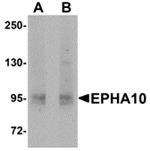Eph receptors, the largest subfamily of receptor tyrosine kinases (RTKs), and their ephrin ligands are important mediators of cell-cell communication regulating cell attachment, shape, and mobility of neuronal and endothelial cells in central nervous system function and in development. Eph receptors can be divided into two subgroups: EphA and EphB. In mammals, the EphA class consists of eight members (EphA 1-7 and 10) that in general bind to ephrin-A members linked to the cell membrane through a glycosylphosphatidylinositol linkage. The EphB class consists of six members (EphB 1-6) that in general bind ephrin-B members that transverse the cell membrane. The Ephrin / EPH signaling pathway networks with the WNT signaling pathway during embryogenesis, tissue regeneration, and carcinogenesis. Recent studies show that Eph/EFN might be relevant in normal B-cell biology and could represent new potential prognostic markers and therapeutic targets for CLL.

